Step 6: Installation and Configuration of Fusion Inventory
17. Now that GLPI is up and running, it is time to add the Fusion Inventory plug-in. Heading back over to the Debian server, the Fusion Inventory plugin can be obtained with another simple wget command.
# cd /var/www/glpi/plugins # wget -c http://forge.fusioninventory.org/attachments/download/1755/fusioninventory-for-glpi_0.85+1.1.tar.gz
18. Now that Fusion Inventory has been downloaded, the contents of the tarball need to be extracted and then ownership changed in order for Apache2 to have access to the new plug-in on GLPI’s behalf:
# tar xzf fusioninventory-for-glpi_0.85+1.1.tar.gz # chown -R www-data:www-data fusioninventory
This above chown command will change the ownership of all the files in the newly extracted folder. The ‘tar‘ command above must be run BEFORE this command!
19. Now all of the files are ready for GLPI to install the Fusion Inventory module. Head back over to the second computer (the one with the web browser) and log-in to GLPI.
At the top of the screen, there are several menu options for GLPI. One of these options will say ‘Setup‘. Hover over this menu and wait for the drop down menu to appear and at the bottom will be a ‘plug-ins‘ option.

20. The next screen will be the installed and ready to be installed list of plug-ins for GLPI. Assuming that Fusion Inventory was placed in the proper directory in the above paragraphs (/var/www/glpi/plugins) this page will show the Fusion Inventory plug-in waiting to be installed.

21. Click the ‘Install‘ button to install Fusion Inventory into GLPI. The page should refresh and then Fusion Inventory will need to be ‘enabled‘ which is done by clicking the newly visible ‘enable‘ button.
Notice that the ‘Status‘ field for Fusion will say ‘Installed / not activated‘ until the ‘Enable‘ button is selected!

22. Once the ‘Enable‘ button is selected, the Fusion Inventory plug-in will now be activated and ready for configuration.
In GLPI, a new ‘Plugins‘ menu will be visible and hovering over the menu will present a drop-down menu labeled ‘FusionInventory‘. Clicking on this option will likely present the following error screen since Fusion does not have a URL for agents to access the system configured yet.

23. To fix this issue, hover over the ‘Administration‘ menu option. When the drop down menu appears, select the ‘Entities‘ dialog. When the page loads, select ‘Root Entity‘ and then on the left side of the webpage, select the ‘FusionInventory‘ selection.
This will allow for the service URL to be set. The service URL in this tutorial can simply be the server’s IP address however, if a functional DNS system (such as BIND9) is setup, an actual URL can be used here as long as the appropriate changes are made in the DNS system as well.
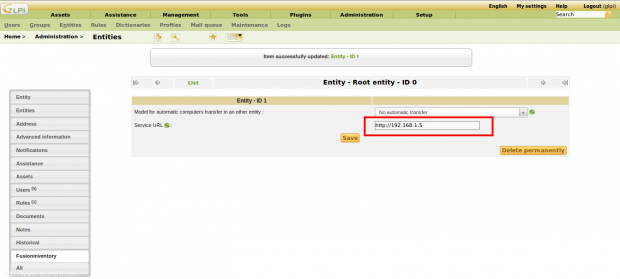
Finally, GLPI and Fusion are ready to go. The next task is to start importing inventory into the system. This tutorial will continue with installing the Fusion Inventory Agent and confirming that the agent properly sends the inventory information to the server.
Step 7: Fusion Inventory Agent Installation
24. Now that all of the difficult stuff is out of the way, it is time to actually test the GLPI/Fusion Inventory system! Fusion has an agent for almost every operating system out there and all of them can be located on the following URL:
25. However, this tutorial will walk through configuring the agent on a Linux machine as the inventory agent is already in the repositories for most distributions.
The agent will be installed on a Linux Mint 17.1 machine in this example. This is a Debian/Ubuntu based distro and it uses the ‘apt‘ meta-packager to obtain packages from the repositories.
# apt-get install fusioninventory-agent
This will install all the necessary dependencies as well as the necessary configuration file for Fusion Inventory. It will be necessary to modify the configuration file in order to tell the agent where the Fusion server resides. The configuration file is located at ‘/etc/fusioninventory/agent.cfg‘ and can be opened with any text editor.
# nano /etc/fusioninventory/agent.cfg
Just to get a machine inventoried, there is only one line that needs to be changed in this particular file and that is the ‘server =‘ line.
For this example the server line should be configured as follows (be sure to substitute the ip for the proper ip or hostname):
server = http://192.168.1.5/plugins/fusioninventory/front/plugin_fusioninventory.communication.php
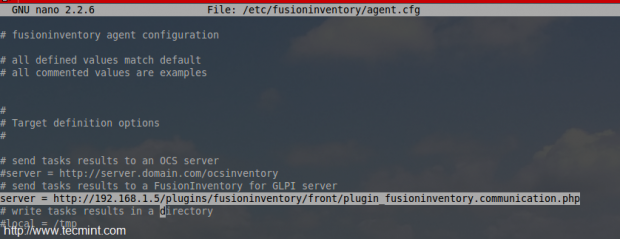
Save the changes to this file and exit out of the text editor.
26. At this point as long as there is network connectivity to the Debian server, Fusion Inventory agent should be ready to inventory this Linux Mint machine. The command to run the agent is ‘fusioninventory-agent‘.
After running this command there wont be much, if any, output. When the command line returns to the normal prompt, it is time to check GLPI/Fusion to see if the machine was inventoried.
There are a couple of places to see whether or not the inventory worked. The first place to look is the agents view in Fusion Inventory. This will show whether or not the client actually connected to the server. To get to this view click on the following menu options: Plugins → FusionInventory → Agent.
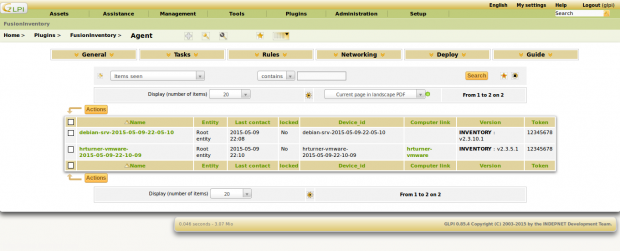
27. This screen shows that the Fusion Inventory agent successfully connected to the server from the test Linux Mint machine. The other place to check is within GLPI’s Assets menu; after all this is where the inventory of machines, software, and peripherals should reside! To access this menu, simply hover over ‘Assets‘ menu in the top left of the web browser and then select ‘computers‘ when the drop down menu appears.
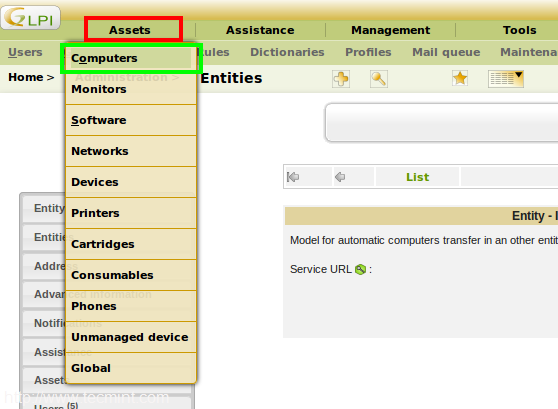
This will bring up the main inventory page. The newly inventoried machine will be the only entity on this page for the time being but should be there never the less.

Success! There is the Linux Mint machine with a small amount of details about the machine. To view more complex details about this machine, simply click on the name of the machine in the column on the far left.
This will present a detailed view of this particular machine’s inventory. Everything from monitors, USB drives, scanners, and software will be displayed here and any information about those devices will also be available.
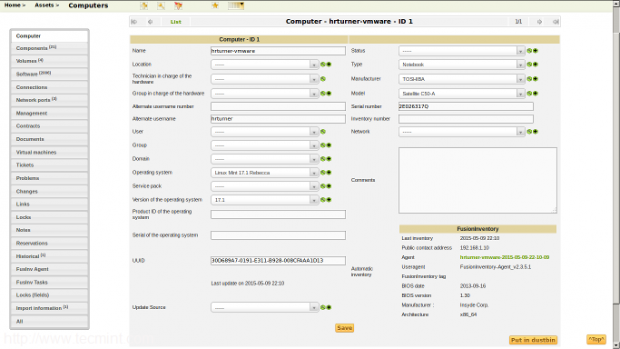
At this point, GLPI and Fusion are working harmoniously and should be ready for more agents to begin transmitting information from other machines! There are currently agents available for all the major operating systems available as well as source code for those who wish to compile from source.
Thank you for sticking through this rather lengthy tutorial and hopefully this tutorial has resulted in a working GLPI/Fusion Inventory system. Please feel free to ask any questions and best of luck inventorying assets!
Resource Link: GLPI HomePage

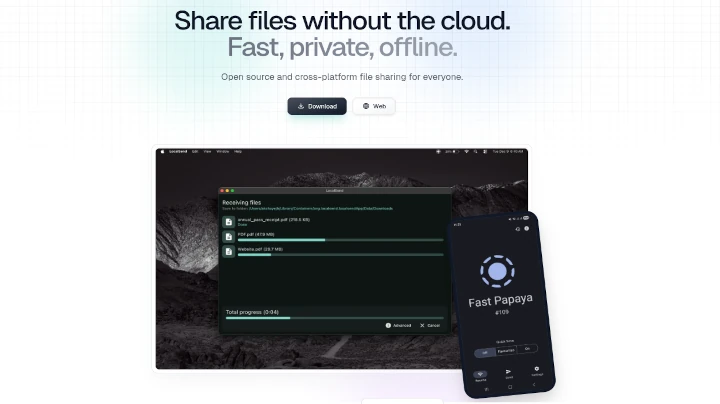

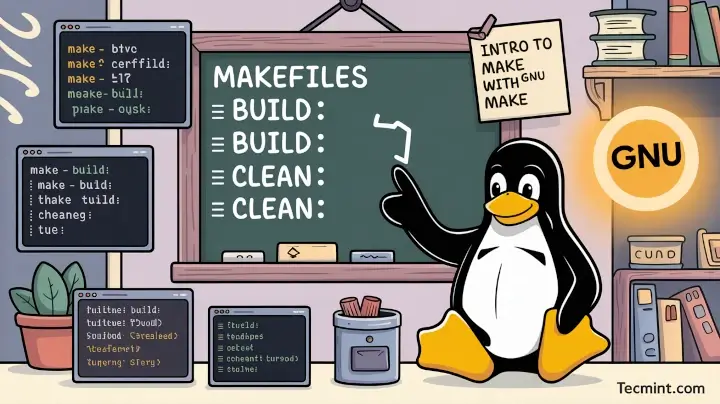
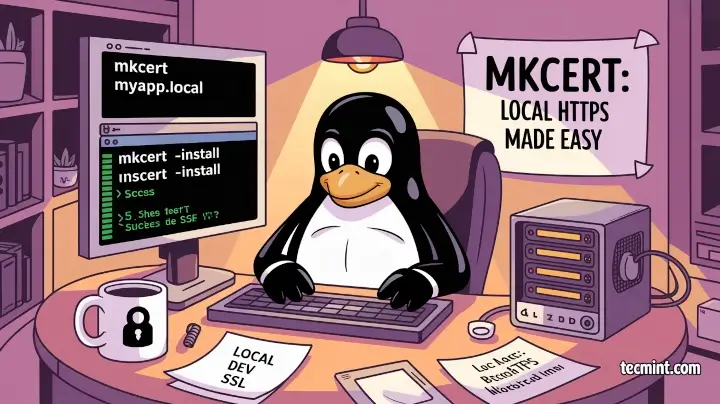


fusion inventory and assets in glpi cant synchronize. I am using fusion inventory agent but they can’t send inventory to assets module.
hi Rob,
1) actually I want to use it as secure site (https)
2) I need only hardware inventory, not software inventory
3) And I want I know server utilization will happen when agent communicate with server (In both end server utility as well as client also)
Can you please help me out in this.
Parthiban,
Thanks for the comment. GLPI does support HTTPS but you’ll have to either use a self-signed certificate or purchase one from a Certificate Authority like Verisign. As for hardware only, I’ve not looked into this yet. I will do some research and see if there is a way to disable software inventory. As for server resources, obviously when hosts start communicating back with the GLPI system resources are going to be used. Watching the unit we have setup, 30 or so clients connecting only uses about 80Mb of RAM during the connection and then frees up when they are done.
Rob
Fantastic and simple article, it worked out perfect for me! Thanks a bunch! As I wanted to eliminate OCS server.
Rob,
You’re quite welcome. Do realize that GLPI does have a newer version out now as well. The new version looks a lot nicer than the version in this article.
Please ignore my comment, I was using a corrupted version of the glpi, it works now. Thanks!
Chaitra,
Glad to hear you got things working! GLPI is a wonderful tool.
Thanks for the insightful article Rob.
I followed the steps you mentioned above, when i enter the IP address of the Apache2 server, I get a 500 error. Any ideas?
Danielle,
Could you provide some more information about which version of GLPI you are using as well as which plugin? There is a much newer version of GLPI out there now and you may be trying to use a plugin or version of GLPI that aren’t compatible with one another.
good day rob!
i now installed fusioninventory and configured the ‘agent.cfg’ file, but how and where do i activate the “fusioninventory-agent” command?
hope for your speedy reply
Danielle,
Once you’ve configured the agent.cfg file, all you need to do is run the “fusioninventory-agent” from the command line interface of the machine you wish to inventory.
Hi Rob Thank You for this wonderful post.
I have successfully install GLPI on Centos 6.7 and add windows and linux system with fusion-inventory.
But How to deploy fusion-inventory remotely from GLPI server because it is not possible to install fusion-inventory one by one in client system.
Regards,
Raghu
Greetings,
I have managed to install GLPI v0.9 on Ubuntu 14.04 LTS with plugin for FusionInventory. The FusionInventory agent on my Ubuntu 16.04 client was also registered in the GLPI database. However, the FusionInventory agent (fusioninventory-agent_windows-x64_2.3.17.exe) on my MS WIndows 7 client was not.
The agent appears to install without error. The host page also loads indicating the version running and an option to manually inventory. I have observed a reference to Strawberry Perl which I was unclear if was required.
Grateful for your support and assistance in resolving this matter.
Pierre Bowrin
I’m having problems with Fusion inventory also.
I cannot start the agent, it shows 404 error.
I think that the error is because I used a Rosehosting tutorial first and then stumbled upon yours article after which i continued from where I left off and installed Fusion inventory.
I think I have to start a new installation.
Ryan,
404 just means that it couldn’t find the resource on the web server. This is still potentially correctable! First thing I would do is make sure that you have the file “/plugins/fusioninventory/front/plugin_fusioninventory.communication.php” where web root is the location of the files for GLPI. If this file exists, check the permissions on all the folders leading up to the file. They must be readable and executable by the user running the webserver (should be apache2 from this guide).
The next thing I would check is on the GLPI client. Make sure that it can ping the webserver that is hosting the GLPI files. Then in the file “/etc/fusioninventory/agent.cfg” be sure that the “server=” line maps correctly to the file above for example: server=http://192.168.1.10//plugins/fusioninventory/front/plugin_fusioninventory.communication.php
Let me know what happens!
Hi Rob i have a problem with LinuMint, when i started the agent i see this :
testmint minttest # fusioninventory-agent start
[error][http client] communication error : 404 not found
[fault] No answer from the Server at /usr/share/fusioninventory/Lib/FusionInventory/Agent.pm line 261.
How can I fix this ? Thanks !
Sam,
This likely means that the url placed in the configuration file is not resolving. Open the agent file located at “/etc/fusioninventory/agent.cfg”. Inside this file there is a line that will start with “server = ” be sure that after the equal sign you place the url for the GLPI system. For example: “server = http://tecmint.tecmint.local/plugins/fusioninventory/front/plugin_fusioninventory.communication.php“. Be sure to change “tecmint.tecmint.local” to your systems hostname. Also make sure that the mint machine you are trying to configure can ping that hostname as well.
yes I followed your guide and I successed install agent in Ubuntu 14.04.3 LTS
My enviroment is
sever: debain jessie installed glpi-0.85.5.tar fusioninventory-for-glpi_0.85.1.3.tar
agent:Ubuntu 14.04.3 LTS
Patrick,
Glad to hear! Hope you enjoy GLPI.
Hi Rob! why is it every time i click the plugin it says “The action you have requested is not allowed.” i correctly installed everything and the plugin just wont work..hope you reply.
Very good post! I follow de instructions, but my instalation have a trouble, the last light (Web access to files directory is protected) is red with red note “Web access to the files directory, should not be allowed. Check the .htaccess file and the web server configuration.” I’m newbe on linux and I lost on this. Any hint? Regards
Douglas,
I’d be sure to check the permissions on the files in the GLPI web directory. Make sure that your apache user owns those files (typically www-data). If that’s not the issue, check in the file /etc/apache2/sites-available/glpi.conf file that there is a line that states “AllowOverride All” or “AllowOverride Limit”. Reply back with the results of these two and we’ll keep trouble shooting.
Hi, i have the same problem than Douglas.
Add Allowoverride All didnt fix it & my /var/www/glpi is owned by www-data:www-data.
I dont’ have a clue why this problem happens..
Any advices ?
Make sure “AllowOverride All” is added between the brackets { } in the htaccess file. What is the path to the htaccess file you manipulated?
I’m currently away from the GLPI system but I will take a look at the installation when I get back but will attempt to help in the meantime.
have you ever thought about adding anything in relation to SSL between agents and the webserver? I have been having much difficulty with having the agent connect through SSL. Would you be updating your instructions to include SSL config as well?
Craig,
I hadn’t thought about that but I will take a look and see if I can get it working. If so, I’ll update the instructions appropriately. Thank you for the idea!
Awesome, I’ve tried a few times but still no luck. If i do get it, i will make sure to add it to the comment section!
While we are adding a host we are facing issue it is detected in fusion inventory & shown in fusion inventory ignored import devices. so these are not added.
I have checked that these device serial no is blank so these are not being added kindly confirm how we can add devices like these in glpi.
Regards
Kapil Kumar
Kapil,
I’m not exactly sure what you are asking. Is fusion not obtaining the serial number for the devices or are the devices not being inventoried?
Hi Rob,
Sorry for the double posts. I was trying to discover computers, not printers, I guess I am unclear of how the Fusion Agent really works. I was under the impression that I could have one agent and be able to scan the network for other computers and populate their info in GLPI. Or do I need an agent installed on every computer on the network? Sorry for the newbie question.
Wayne
Wayne,
Thanks for the clarification. There are a couple of different options available. For computer inventory, generally companies want to know what software is installed, revision numbers, etc. As such, the fusion inventory agent client would need to be installed on the computer in order to report that information. However the network discovery would provide some basic functionality but it does require the use of SNMP. So if there was a computer that needed to be inventoried but you don’t want to install fusion agent on the machine, you could configure an SNMP user on that machine and then provide the Fusion Inventory server with the SNMP user credentials to access that machine. Does that help? If not let me know and I’ll come up with an illustration or better description.
Hi Rob,
Fantastic post! Thank you. Any assistance with Network Discovery or a place a you could direct me to? I cannot get Fusion Inventory to scan my network, through GLPI. After setting an IP range, changing the agent settings, adding a task including target and actor…I cannot perform a Network Discovery.
Hi Rob,
Fantastic post! I have followed your instructions but I have one question regarding network discovery. I was hoping you could help me out or point me in the right direction. I cannot seem to get network discovery to work. I have entered IP ranges, created a task through Task Management, configured the agent module for network discovery on an agent, and added targets and actors but nothing seems to happen after that. Any assistance would be appreciated. Again, great post!
Wayne
Wayne,
Do you mean network discovery as in locating devices on a network or locating network devices? If you are referring to the later, I had to configure SNMP users on the network devices themselves in order for Fusion Inventory to query/inventory those devices. If you are talking about simple network discovery of hosts, I’ll check what I did later this evening.
GLPI fusioninventory agent not working with ubuntu-14.04.2
Sarfaraz, Could you provide some more detail? I tested Fusion inventory from Mint 17.1 which is based on Ubuntu 14.04 and it has worked flawlessly.
Ryan,
Not a problem at all! Best of luck and if you run into any issues, please let us know. We’ll be glad to assist.
Tremendous Job. Excellent
Sarfaraz,
Thank you. GLPI/Fusion Inventory are wonderful pieces of software that have saved me tons of time. Hoping that others can benefit as much from these two pieces of software.
Hi Rob !
Thank you so much for this guide, it helped me a lot !! Especially the part with fusion inventory, I’ll set it up tomorrow thanks to you !
Regards
Ryan